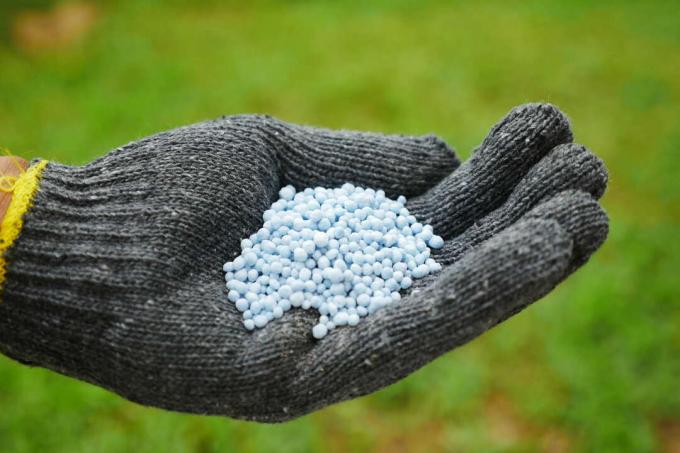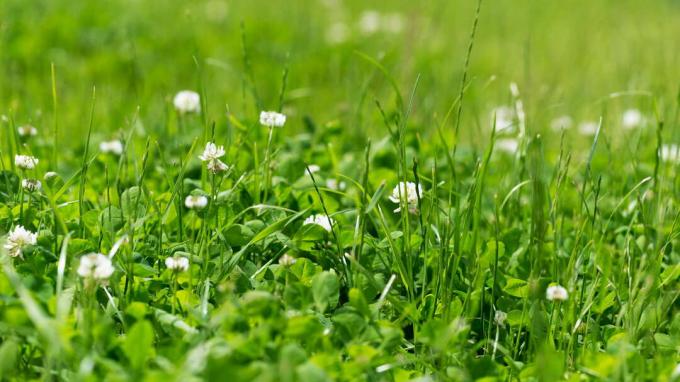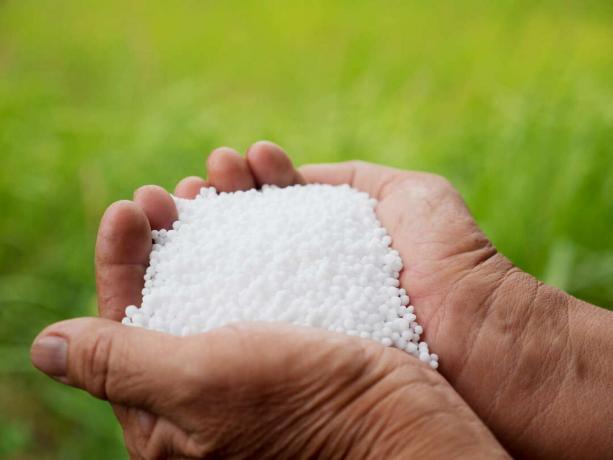Nitrogen fertilizer ensures a lush green lawn. Here we explain how to optimally supply your lawn with nitrogen and what needs to be considered.

Nitrogen is required by all plants in large quantities and lawns in particular have a particularly high need. In this article you can learn how and when to best apply nitrogen and how to identify a nitrogen deficiency or excess. You will also receive tips on choosing the right fertilizer.
contents
-
Why does the lawn need nitrogen?
- Nitrogen fertilizer: when to fertilize?
- Nitrogen fertilizer against moss in the lawn
- Recognizing nitrogen deficiency in the lawn
-
Nitrogen fertilizer for lawns: application and application
- Organic nitrogen fertilizer
- Mineral nitrogen fertilizer
A lawn can only show the desired properties if it is supplied with nutrients according to its needs. The lawn is a heavy consumer, so it needs all nutrients in relatively large quantities. Nitrogen (N) is of enormous importance for all plants - including the lawn. It is part of chlorophyll, DNA and many proteins necessary for plant life and development.
Why does the lawn need nitrogen?
As the "engine of vegetative growth" it is required by lawns in particularly large quantities, because nitrogen is constantly removed from them in the form of lawn clippings as a result of the recurring mowing will. Anyone who now concludes that omitting nitrogen fertilization leads to a beautiful lawn with less mowing work is unfortunately on the wrong track. Frequent mowing alone stimulates the constant branching of the lawn plants. This results in a dense and hard-wearing turf while effectively suppressing weeds.

Nitrogen fertilizer: when to fertilize?
Nitrogen as the "engine of vegetative growth" fuels the lawn drive. This is very welcome in spring and summer when a lawn is mowed and used a lot. A strong shoot also means a strong competitive power against wild herbs. But there are times when little or no nitrogen is needed and even causes damage. At the beginning of spring, when the weather is mild, the lawn is roused from hibernation with a fast-acting, nitrogen-rich lawn fertiliser. This becomes problematic when heavy frost sets in again after a few mild days. The driven stalks still have a low frost tolerance and can therefore easily freeze to death. They die off, lie yellow on the rest of the lawn, shade it and thus prevent further growth. You can find out more about whether your lawn has one in our special article here Lawn fertilization in spring needed to expel.
In early autumn you should prepare the lawn for the cold temperatures of winter. If nitrogen-rich fertilization is carried out too late in the year and the nutrients are suddenly available, the same happens as described above for spring. The sprouting stalks are not sufficiently frost hardy and the lawn is more likely to go into winter damaged. We therefore recommend that the last lawn fertilization should not be carried out too late. In this article you can find out about the right one Lawn fertilization in autumn to inform.
tip: Use a predominantly organic lawn fertilizer such as our Plantura Organic Lawn Fertilizer. You can apply this from the month of February and its release depends on the weather. The nutrients only become available to the plants slowly, so that there is no sudden surge of frost-sensitive stalks. Therefore, organic lawn fertilizers can still be used in autumn without hesitation.
Nitrogen fertilization can also be problematic in very hot summers. Lawn growth stimulated by a lot of nitrogen is also not well positioned to deal with dry air and lack of water. The result can now be drought damage, after all the stalks can no longer compensate for their high transpiration rate with water absorption. Since mowing too often in hot summers also damages the lawn, you should avoid mineral fertilizers with too high a nitrogen content during these months.
Nitrogen fertilizer against moss in the lawn
A sufficient supply of nitrogen is always the indispensable basis for preventing moss growth. Because what is certain is that an insufficiently nourished lawn is not competitive enough to keep moss in check. But moss in the lawn can have other causes: lack of light, lack of oxygen at the roots Waterlogging and/or soil compaction are just as possible as a soil pH value that is too low (below 6). Since these various causes - also in combination - cause moss in the lawn, strong nitrogen fertilization is by no means a panacea against moss in the lawn. If you want to learn how Fighting moss in the lawn you can also take a look at this special article.

Recognizing nitrogen deficiency in the lawn
Since lawns require a large amount of nitrogen, a deficiency quickly becomes noticeable. During the growing season and mowing season, you can recognize it by the slowdown in growth and associated fewer mowings. Now at the latest it is time to supply nitrogen in the form of fertilization. An acute deficiency can be recognized by the complete yellowing of the grass, because nitrogen is needed to build up chlorophyll. However, freshly sprouted stalks are often still green because nitrogen can be transported from the old leaves to the new ones. If your lawn is chronically under-nourished, this can be recognized by a thin turf through which the soil shimmers everywhere. Many weeds in the lawn also indicate malnutrition: Some of them can cope with fewer nutrients than the lawn plants. But also one Lawn over-fertilization with nitrogen is possible: This special article deals with the over-fertilization of lawns.
Tip from the pro: Clover and dandelion are indicator plants for nitrogen deficiency or excess. white clover (Trifolium repens) is adapted to lean, nitrogen-poor soils. As a legume, it is able to enter into a symbiosis with so-called rhizobacteria, which bind nitrogen from the air and make it available to plants. For this reason, the presence of clover in the lawn indicates a lack of nitrogen nutrition. Unfortunately, this does not mean that the clover disappears after a fertilization: once it is well established, sometimes only generous removal and reseeding helps to get rid of it. Dandelion (Taraxacum sct. ruderals) prefers the exact opposite: it prefers to grow in nutrient-rich locations and thus indicates that there is no deficiency.

Like you white clover, dandelion and others Banish wild herbs from the lawn you can find out here.
Nitrogen fertilizer for lawns: application and application
Even if nitrogen is of outstanding importance for the lawn, nitrogen fertilization alone is not necessary. The necessary nitrogen is usually applied in combination with the other plant nutrients as lawn fertilizer. The nitrogen requirement depends on how the lawn is used: A heavily used, frequently mown hard-wearing lawn requires 20 to 30 grams of pure nitrogen per square meter and year. On the other hand, 10 to 20 grams of pure nitrogen per square meter and year are sufficient for a typical lawn. You can find the nitrogen content in percent in the declaration of the fertilizer used.
The indication "10 - 4 - 6 - 2" indicates that 10% nitrogen, 4% phosphorus compounds, 6% potassium compounds and 2% magnesium compounds are contained. If you apply one kilogram of such fertilizer, you have distributed 100 grams of pure nitrogen.
When dosing nitrogen and lawn fertilizers, you should always follow the recommendations of the respective manufacturer. Note that the amount of pure nitrogen applied at once should never exceed the limit of 5 grams per square meter for mineral fertilizers. Otherwise the lawn could be washed out and damaged. To stay within this limit anywhere on the lawn, we recommend using fertilizer spreaders where the size of the lawn allows. The application of larger quantities as long-term fertilizer or organic fertilizer is unproblematic.

Organic nitrogen fertilizer
Some organic fertilizers mainly contain nitrogen and can be used to nourish the lawn. However, always remember that the other nutrients are also necessary for maintaining a healthy lawn. Horn fertilizers contain 10 to 14% nitrogen. Depending on the degree of comminution, they act at different speeds: horn meal faster than horn semolina and this faster than horn shavings. During the growing season, you can apply 50 grams of horn meal per square meter every six weeks. The use of coarser horn fertilizer allows larger doses and longer fertilization intervals. Unless the soil under your lawn has a proven excess of potassium, phosphate and magnesium, it is better to fertilize with a full-fledged lawn fertilizer. We have our primarily organic Plantura for the sustainable fertilization of your green spaces Organic Lawn Fertilizer as well as our organic Plantura Organic autumn lawn fertilizer developed, which ensure gentle care of the lawn while at the same time improving the soil quality.
Mineral nitrogen fertilizer
Pure mineral nitrogen fertilizers are not actually needed or used in the private sector. The reason lies in the numerous dangers that its use entails: over-fertilization, leaching and frost damage are much more frequent with mineral fertilizers and especially with nitrogen than with organic or organo-mineral ones fertilizers. In the case of an acute nitrogen deficiency, the application can certainly be useful: A Lawn liquid fertilization with urea or the application of calcium ammonium nitrate acts many times faster than any organic nitrogen fertilizer. However, since an acute deficiency can be avoided with the regular use of long-acting lawn fertilizers, their use should be the exception and not the rule.

More information about the different lawn fertilizers get here. Everything else on the topic "fertilize lawnYou can also find out more here in our overview article.
